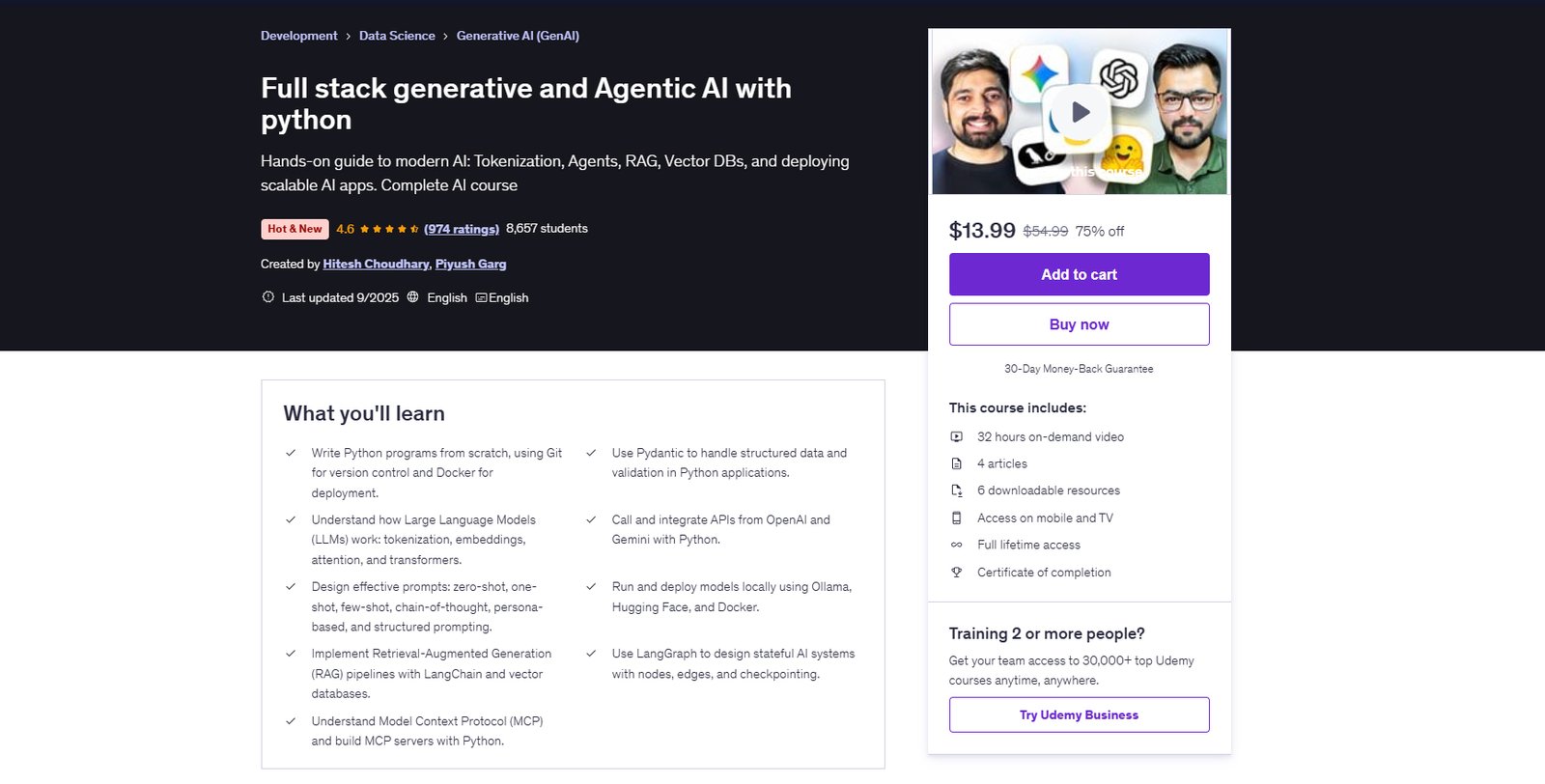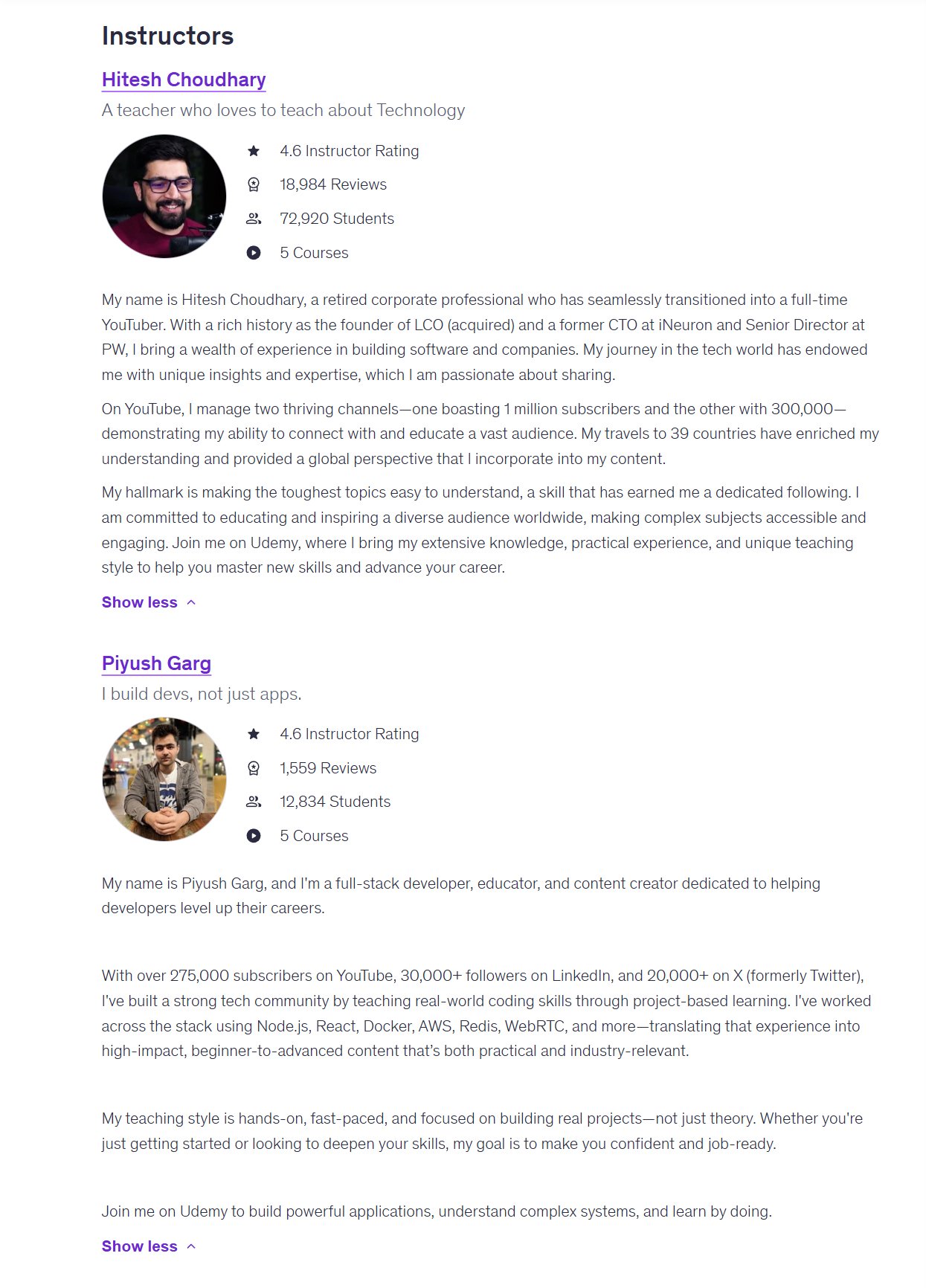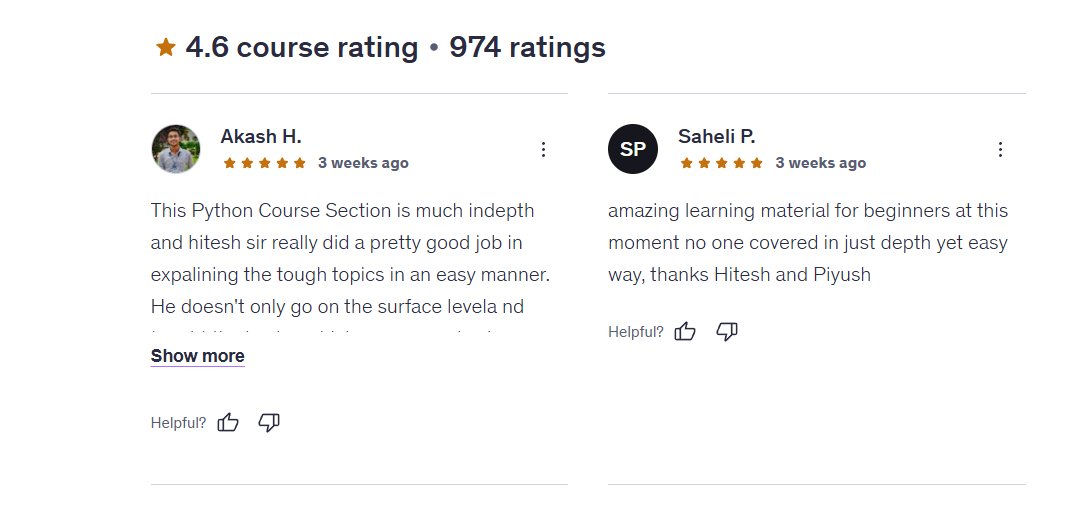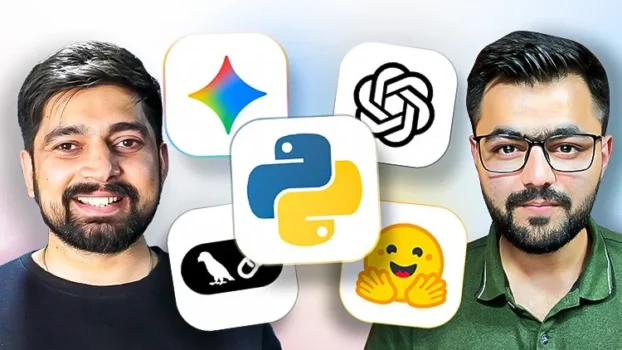The “Full Stack Generative and Agentic AI with Python” course on Udemy, taught by industry experts Hitesh Choudhary and Piyush Garg, is designed to transform you from a coding novice or a traditional developer into a job-ready AI Engineer.
This isn’t just another introductory course on Large Language Models (LLMs); it’s a deep dive into the full-stack ecosystem—covering Python, Git, Docker, and then pushing into cutting-edge topics like RAG pipelines, LangGraph, Multi-Modal AI, and Agentic Systems. If you want to build the next-generation of AI applications, this is the course you need.
- Course Title: Full stack generative and Agentic AI with python
- Instructors: Hitesh Choudhary & Piyush Garg
- Total Content: 32 hours on-demand video, 4 articles, 6 downloadable resources
- Access: Full lifetime access, accessible on mobile and TV
- Certification: Certificate of Completion
What You Will Actually Learn
The curriculum is meticulously structured, starting with a robust foundation and rapidly progressing to advanced, in-demand topics.
The Full-Stack AI Foundation
- Before diving into AI, you’ll master the essential tools of any professional developer:
- Python Programming from scratch (syntax, OOP, advanced features).
- Git & GitHub for professional version control.
- Docker for containerization and reliable, scalable deployment.
- Pydantic for structured, type-safe data handling in modern Python applications.
Deep LLM Mechanics
Unlike courses that just show you how to call an API, this bootcamp breaks down the core concepts:
- How LLMs (like GPT) actually work: Tokenization, Embeddings, Attention, and Transformers explained simply.
- Understanding multi-head attention and the “Attention is All You Need” paper.

State-of-the-Art Techniques
This is where the course truly shines, focusing on the latest tools and methodologies:
- Prompt Engineering Mastery: Learn zero-shot, few-shot, Chain-of-Thought, and Persona-Based Prompting for optimal results.
- Retrieval-Augmented Generation (RAG): Implement complete RAG pipelines using LangChain and Vector Databases. You’ll even learn to scale RAG using Redis/Valkey Queues.
- AI Agents with LangGraph: Go beyond simple chains. Use LangGraph to design stateful, graph-based AI systems with nodes, edges, and MongoDB checkpointing.
- Local & Cloud Deployment: Run models locally with Ollama and Hugging Face, and integrate them into FastAPI endpoints.
- Memory Systems: Implement sophisticated memory layers—short-term, long-term, episodic, and Graph Memory with Neo4j.
- Conversational & Multi-Modal AI: Build a voice-based assistant (like a Cursor IDE clone) by integrating speech-to-text (STT) and text-to-speech (TTS), and work with image/text multi-modal LLMs.
Real-World Projects for Your Portfolio
The best way to learn is by building. You will complete high-impact projects, including
- A Tokenizer from scratch.
- A scalable Queue-based RAG system with Redis and FastAPI.
- A Python CLI-based coding assistant.
- A fully functional AI conversational voice agent.
- An advanced LangGraph agent with Neo4j for graph memory.

Pros and Cons
Looking for an in-depth, practical course to master Full-Stack AI development with Python? Here is a breakdown of the course’s pros and cons to help you decide if it’s the right fit for your learning journey.
Pros
Why Students Highly Recommend This Course
The vast majority of students praise this course for its quality, structure, and the instructors’ engaging teaching styles.
Exceptional AI and Advanced Concepts Coverage
- Deep Dive into Modern AI: The section on Generative AI and Agentic AI (taught by Piyush Garg) is consistently highlighted as “insane,” “great,” and “very insightful.” Students particularly appreciate the coverage of advanced tools and concepts like LLMs, RAG, Agents, and LangGraph.
- Practical, Project-Minded Approach: The course is structured to teach with a “Software Developer’s Mindset,” focusing on practical application. One reviewer noted it “opened all doors for me to implementing ai in my own apps.”
- Structured and Smooth Flow: The course is lauded as “one of the best structured AI courses,” moving seamlessly from Python fundamentals to advanced AI topics. The clear explanation of fundamentals before diving into Generative AI makes the entire journey easy to follow.
Clear, Engaging, and Confidence-Boosting Instructors
- Hitesh Choudhary’s Engaging Style: Hitesh is praised for making complex concepts a “cake walk,” teaching in a “very easy to understand” way, and for his unique, fun teaching methods (like incorporating “Chai” into almost every topic).
- Building Confidence and Curiosity: Both instructors are noted for not just teaching facts, but for building confidence in learners and encouraging them to “think” and “experiment beyond the taught concepts.”
- Clear Articulation and Follow-Along: Students found the instructors’ articulation “very clear and easy to understand,” making it simple to follow along and grasp tough topics.
Perfect for Both Beginners and Intermediates
- Comprehensive Python Foundation: The course starts from the “absolute basics of Python,” making it an excellent starting point for complete beginners or those looking to solidify their fundamentals.
- Intermediate Value: Even intermediate to upper-intermediate Python developers found the course valuable, noting it was “clearing my basics even more” and offered a great variety of topics and “mini-project like problems.”
Cons
Areas for Improvement and Potential Drawbacks
While the course is overwhelmingly positive, a few constructive criticisms were noted by students, primarily concerning the depth and pacing of certain sections.
Python Section Pacing and Depth Concerns
- Pacing Too Slow for Some: A few experienced developers mentioned that the initial Python section went “very slow,” suggesting the course might be geared more toward true beginners or those with minimal Python experience.
- Mixed Reviews on Python Quality: One student found the Python section to be “below average,” contradicting the high praise from others and the course’s marketing as the “World’s Best Python Course.” This suggests the style of Python instruction may not appeal to everyone.
Desire for Deeper AI Concepts
- Request for More Advanced Depth: While the breadth of AI tools was appreciated, one student felt that certain advanced topics could have been “explored in more depth” to provide a stronger conceptual understanding alongside the tool exposure.
- Need for More Complex LangChain Flows: Specifically, a student who jumped directly to the AI part requested “more depth in complex langchain flow” content to further enhance their advanced knowledge.

Who Should Take This Course?
Best For
- Absolute Beginners who need a clear, structured path from Python basics to advanced AI.
- Developers looking for a practical, tool-heavy introduction to Generative AI and Agentic AI.
- Learners who appreciate an engaging, confidence-boosting teaching style.
Consider If
- You are an experienced Python developer, you may find the initial sections too slow, but the AI content is worth the time jump.
- You require an extremely deep, theoretical dive into niche AI concepts—you may need supplementary material.



